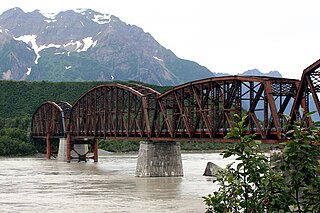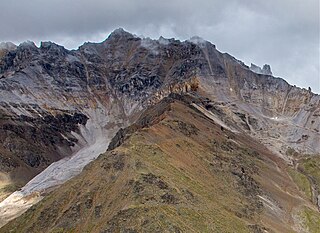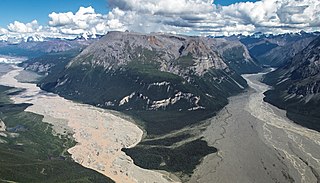
Chisana is a census-designated place (CDP) in the Copper River Census Area in the U.S. state of Alaska. As of the 2010 Census, the population of the CDP was 0. The English name Chisana derives from the Ahtna Athabascan name Tsetsaan' Na, meaning literally 'copper river'. The Chisana River joins the Nabesna River just north of Northway Junction, Alaska, to form the Tanana River, a major tributary of the Yukon River. The Chisana Airport consists of a turf and gravel runway which is largely serviced by flights from Tok, Alaska.

Chitina is a census-designated place (CDP) in Copper River Census Area, Alaska, United States. At the 2010 census the population was 126, up from 123 in 2000.

McCarthy is a census-designated place (CDP) in Copper River Census Area, Alaska, United States. It is in Wrangell-St. Elias National Park and Preserve. The population was 107 at the 2020 census, up from 28 in 2010.

The Miles Glacier Bridge, also known as the Million Dollar Bridge, was built in the early 1900s across the Copper River fifty miles from Cordova in what is now the U.S. state of Alaska. It is a multiple-span Pennsylvania truss bridge which completed a 196-mile (315 km) railroad line for the Copper River and Northwestern Railway, built by J. P. Morgan and the Guggenheim family to haul copper from the old mining town of Kennicott, now located within the Wrangell–St. Elias National Park and Preserve, to the port of Cordova. It earned its nickname because of its $1.4 million cost, well recouped by the about $200 million worth of copper ore which was shipped as a result of its construction.

The Copper River or Ahtna River, Ahtna Athabascan ‘Atna’tuu, "river of the Ahtnas", Tlingit Eeḵhéeni, "river of copper", is a 290-mile (470 km) river in south-central Alaska in the United States. It drains a large region of the Wrangell Mountains and Chugach Mountains into the Gulf of Alaska. It is known for its extensive delta ecosystem, as well as for its prolific runs of wild salmon, which are among the most highly prized stocks in the world. The river is the tenth largest in the United States, as ranked by average discharge volume at its mouth.

Wrangell–St. Elias National Park and Preserve is an American national park and preserve managed by the National Park Service in south central Alaska. The park and preserve were established in 1980 by the Alaska National Interest Lands Conservation Act. The protected areas are included in an International Biosphere Reserve and are part of the Kluane/Wrangell–St. Elias/Glacier Bay/Tatshenshini-Alsek UNESCO World Heritage Site. The park and preserve form the largest area managed by the National Park Service with a total of 13,175,799.07 acres, an expanse larger than nine U.S. states and around the same size as Bosnia and Herzegovina or Croatia. 8,323,147.59 acres are designated as the national park, and the remaining 4,852,652.14 acres are designated as the preserve. The area designated as the national park alone is larger than the 47 smallest American national parks combined and is more than twice the size of all but two other national parks. Its area makes up over 15% of all national park designated land in the United States.

Kennecott, also known as Kennicott and Kennecott Mines, is an abandoned mining camp in the Copper River Census Area in the U.S. state of Alaska that was the center of activity for several copper mines. It is located beside the Kennicott Glacier, northeast of Valdez, inside Wrangell-St. Elias National Park and Preserve. The camp and mines are now a National Historic Landmark District administered by the National Park Service.

The Copper River and Northwestern Railway (CR&NW) consisted of two rail lines, the Copper River line and the Northwestern line. Michael James Heney had secured the right-of-way up the Copper River in 1904. He started building the railway from Cordova, Alaska in 1906. The town of Cordova, Alaska, was actually named by Heney on March 13, 1906, based on the original name given by Salvador Fidalgo. Both these railroads were abandoned and little remains of them. A 0-4-0 locomotive, "Ole", located near Goose City on a siding of the Alaska Anthracite Railroad Company is the only equipment left. Many of the holdings of the CR&NW railroad including Ole were acquired for this railroad by Mr. Clark Davis and his partners in 1908 after a major storm destroyed the Katalla area facilities in 1907. The town of Cordova would like to move Ole to a memorial site in Cordova to celebrate its role in these railroads. Ole was declared eligible for the National Register of Historic Places in 1988.

The McCarthy Road is a gravel-surfaced road that runs from the end of the Edgerton Highway in Chitina, Alaska, to about 1 mile (1.6 km) outside of McCarthy, Alaska.

The Bremner River is a 40-mile (64 km) tributary of the Copper River in the Valdez–Cordova Census Area of the U.S. state of Alaska. It was named in 1885 by Lieutenant H. T. Allen for John Bremner, a prospector who sought gold along the river and was the first non-native person to go there.
Nabesna is a census-designated place and unincorporated community in northern Copper River Census Area, Alaska, United States, in the northern part of the Wrangell-St. Elias National Park and Preserve. It lies along the Nabesna Road, a gravel road that connects it to the Tok Cut-Off at Slana. Its elevation is 2,979 feet (908 m). Founded by and named for the Nabesna Mining Company, the community received a post office in 1909. Located at the base of White Mountain in the Wrangell Mountains, it lies west of the Nabesna River. According to the 2020 census, there were two people residing at this location.

The Alaska–St. Elias Range tundra is an ecoregion of northwestern North America.
John Bremner (1833–1887) was a prospector and early explorer of Alaska.
This is a list of the National Register of Historic Places listings in Wrangell–St. Elias National Park and Preserve.
Kansky's, also known as Kanski's, Big Skookum, and Devil's Mountain Lodge, is a former boarding house, now used as a hunting lodge, located at mile 42 of the Nabesna Road in Wrangell–St. Elias National Park and Preserve of eastern Alaska. The property includes a log cabin, bunkhouse, and storage building, which were built in 1934 by Steve Kanski to provide lodging and travel services to road crews and workers at the nearby mines. The property, a private inholding within the bounds of the national park, is now operated as a hunting lodge.
In an effort to thwart statehood and Alaskan home rule from Washington D.C., the "Alaska Syndicate," was formed in 1906 by J. P. Morgan and Simon Guggenheim. The Syndicate purchased the Kennicott-Bonanza copper mine and had majority control of the Alaskan steamship and rail transportation. The syndicate also was in charge of a large part of the salmon industry.

The McCarthy General Store is a historic former general store and boarding house at Kennecott and Skolai Streets in the small community of McCarthy, Alaska, located in the heart of Wrangell-St. Elias National Park and Preserve. At two stories in height and measuring 47 by 56 feet, it is McCarthy's largest building, and one of its oldest. It was built in 1914, during the mining boom at nearby Kennecott. The store occupied the ground floor of the building, and the upper level had eleven rooms for boarders. The building was abandoned after the mining boom ended in the 1930s,.
The McCarthy Power Plant, also known as the Mother Lode Coalition Mining Company Power House and the Mother Lode Plant, is a historic power plant building in the small community of McCarthy, Alaska, in the heart of Wrangell-St. Elias National Park and Preserve. It is a three-story wood-frame structure with a clerestory roof, located on the banks of McCarthy Creek. It was built in 1917, after the arrival of the Copper River and Northwestern Railway in the area kicked of a building boom. The coal-fired power plant was built to provide electricity for the operation of a tramway and other facilities of the Kennecott mines. Most of the transmission lines and the tramway were destroyed by avalanches in 1919, and other changes made soon afterward made the power plant unnecessary, and its turbine was moved up to Kennecott.

Bonanza Peak is a 6,983-foot mountain summit located in the Wrangell Mountains, in the U.S. state of Alaska. The peak was notable for its abundance of copper deposits which were mined from 1909 through 1938. The peak is situated in Wrangell-St. Elias National Park and Preserve, immediately northeast of Kennecott, 7 mi (11 km) northeast of McCarthy, 3.46 mi (6 km) north of Porphyry Mountain, and 5.2 mi (8 km) southeast of Donoho Peak. The confluence of the Kennicott and Root Glaciers lies below the mountain's west slope. Precipitation runoff from the mountain drains into tributaries of the Nizina River, which in turn is part of the Copper River drainage basin. The mountain's local name was reported in 1914 by the U.S. Geological Survey. On a clear day the summit of Bonanza Peak offers views of Sourdough Peak, Mount Blackburn, and Fireweed Mountain.

Chitistone Mountain is a 6,844-foot (2,086-meter) mountain summit located at the southeastern edge of the Wrangell Mountains, in the U.S. state of Alaska. The peak is situated in Wrangell-St. Elias National Park and Preserve, 15 mi (24 km) east-northeast of McCarthy, 13 mi (21 km) east of Bonanza Peak, and 12 mi (19 km) north of Williams Peak, where it is wedged between the confluence of the Nizina River and Chitistone River.
















